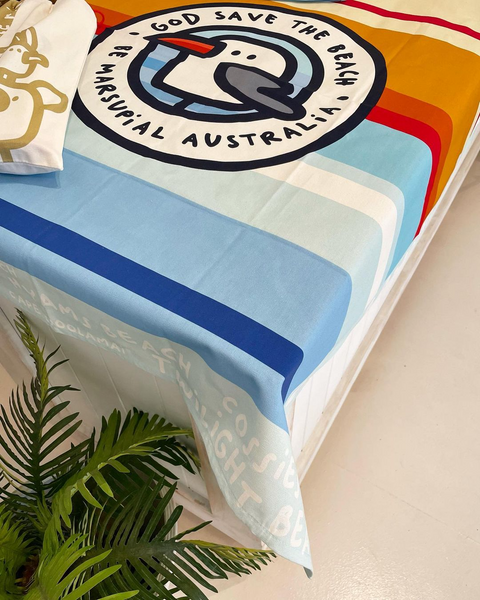Elegant Table Cloths to Enhance Your Dining Table Setting
Elegant Table Cloths to Enhance Your Dining Table Setting
Blog Article
The Ultimate Guide to Selecting the Suitable Bed Cover for Your Home
Choosing the perfect bedspread for your home is a nuanced process that needs mindful factor to consider of a number of crucial factors, consisting of product, upkeep, size, and design. As we check out these dimensions better, you might find that the excellent bedspread is not just an attractive product, however a vital part of your living space.
Kinds Of Bedspreads

First of all, standard bed covers are characterized by their all-encompassing design, usually covering the entire bed, including the cushions. These are padded or frequently quilted, offering warmth and a classic look. In comparison, coverlets are lighter and commonly used in warmer environments, including an extra customized appearance that falls just to the sides of the cushion.
For a much more informal ambiance, bed linen are prominent choices. They encase a comforter and can be easily removed for washing, permitting flexibility in vogue. In a similar way, comforters are thicker and usually loaded with synthetic fibers or down, making them a superb option for colder months.
Lastly, tosses or bed coverings provide an attractive element while giving extra warmth. They can be draped over the bed or made use of individually for a cozy touch. By taking into consideration these types, you can much better straighten your choice with your functional requirements and aesthetic choices, ultimately boosting your bedroom's setting.
Material Factors To Consider
Choosing the best product for your blanket plays a significant duty in both convenience and sturdiness. The material you pick can influence not only the visual of your bedroom yet likewise how well the bed cover carries out over time. Typical materials for bed coverings include cotton, silk, polyester, and bed linen, each offering distinctive benefits.
Cotton is a preferred choice due to its breathability, soft qualities, and ease of treatment. It is hypoallergenic, making it a superb option for those with level of sensitivities - table cloths. Polyester, on the other hand, is sturdy and immune to wrinkles and fading, supplying a low-maintenance choice
Linen, understood for its natural texture and breathability, provides a luxurious feel yet may require more careful maintenance to avoid wrinkling. Silk bed covers, while soft and stylish, can be much less sturdy and commonly call for completely dry cleaning, making them fit for more official setups.

Design And Style Options
A broad selection of design and style choices is readily available for bed covers, permitting property owners to share their personal visual while boosting the overall atmosphere of the bed room. From timeless quilts to contemporary coverlets, bed coverings are available in different styles that deal with diverse preferences and choices.
Traditional styles often include rich structures and detailed patterns, making them suitable for vintage or rustic-themed interiors. On the other hand, modern bedspreads often tend to accept minimalism with clean lines and strong shades, best for scandinavian-inspired or contemporary areas. For those looking for a diverse appeal, bohemian styles existing dynamic shades and blended patterns, adding a playful touch to any type of room.
Along with style, the choice of style aspects such as prints, embroidery, and shade combinations can dramatically affect the atmosphere of the bedroom. Floral concepts stimulate a feeling of peace, while geometric patterns can create a more dynamic and energetic feel. Ultimately, selecting the appropriate bed covering includes taking into consideration both visual choices and the preferred state of mind for the room, making certain that it complements existing decoration while offering comfort and aesthetic rate of interest.
Size and Fit
The option of a bedspread expands past aesthetics; dimension and fit are important elements that identify both performance and the general appearance of the bed linens ensemble. table cloths. An uncomfortable bed cover can detract from the aesthetic consistency of an area and might result in useful obstacles, such as inadequate insurance coverage or extreme bulk
To guarantee the appropriate size, start by determining your cushion dimensions-- size, elevation, and size. Think about the preferred decrease length, which refers to how much the bedspread hangs over the sides of the cushion.
In addition, take right into account any added bedding components, such as cushion toppers or attractive cushions, which may influence the overall fit. When choosing a bed cover, it is a good idea to select layouts that supply some flexibility in sizing, such as extra-large alternatives. This approach makes sure that the blanket fits differing table cloths mattress heights and styles, boosting both convenience and aesthetic appeal in your bed room.
Upkeep and Treatment
Appropriate upkeep and treatment are important for extending the life of a bed cover and maintaining its visual allure. Normal cleaning and interest to care directions specific to the material are crucial steps in keeping its quality. A lot of bed coverings can be equipment washed, but it is recommended to inspect the label for any kind of special requirements.
To ensure durability, laundry bed covers in cool water with a gentle cycle, utilizing a moderate detergent. Avoid bleach, as it can break down the material and alter colors. For delicate fabrics like silk or specific synthetics, hand washing may be much more proper. After cleaning, air drying out is recommended; if using a dryer, choose a reduced warm establishing to protect against shrinkage and damage.
Furthermore, turning your bedspread regularly can reduce use on certain locations. If spills take place, resolve them quickly by blotting instead of rubbing, to stop stains from establishing. For bed coverings that need completely dry cleansing, stick to a timetable to keep quality and cleanliness.
Conclusion
Selecting the suitable bed covering demands careful factor to consider of various elements, consisting of material, upkeep, design, and dimension needs. The choice of fabric, whether breathable cotton, sturdy polyester, or elegant silk, ought to straighten with private way of life and climate requirements. Additionally, the bed covering's design must match existing style while ensuring a proper fit for the cushion. Focusing on upkeep and treatment will better enhance the long life and visual charm of the blanket, eventually contributing to a well-coordinated bedroom environment.
Picking the ideal bedspread for your home is a nuanced process that requires careful consideration of numerous key factors, including product, maintenance, size, and style. The product you select can influence not only the visual of your bedroom yet also how well the bedspread performs over time. Typical materials for blankets consist of cotton, linen, polyester, and silk, each offering distinctive benefits.
Picking the suitable blanket necessitates cautious consideration of various variables, consisting of material, size, design, and upkeep requirements. Prioritizing upkeep and treatment will additionally boost the longevity and visual allure of the bedspread, inevitably contributing to a well-coordinated room environment.
Report this page